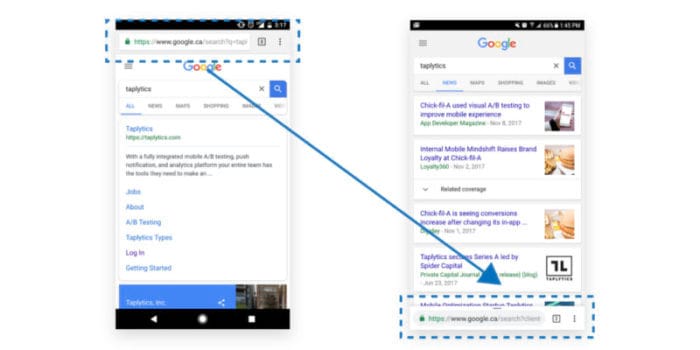Who’s Part of Google Chrome’s Mobile App Rollout

Google Chrome’s Mobile App release provided a new experience for users. Here’s a quick summary of how we noticed the differences.
Earlier this week, some of our team noticed that the address bar in their Android Google Chrome app was at the bottom of their screen instead of at the top where it usually was. Additionally, the way that they open new tabs has changed and a content recommendation hub was added, all without an app update. One team member came into the office to compare with other Android users to find that no one else had the update even though they were all running the same app version. By day’s end, one other Android user had the new bar as well.
What does this mean?
Updates like this one that aren’t ubiquitous are commonly mistaken for a fixed new feature or a test. But that isn’t what’s happening here.
We are part of a rollout.
Rollouts are a very common tactic that companies use to release new features, UI, and functionalities. When you notice a change on your favourite sites or apps, it’s very likely that not all users are experiencing the change at the same time. Many people think a change like the address bar is permanent but it’s not; companies like Google share releases with users in waves as an experiment that could very well be rolled back if the feature is not well-received. Rollouts are a great way to share your changes with some users and measure its impact without fully committing.
For example, when Facebook introduced the native camera into Messenger, and Instagram made the switch to the white interface, it was rolled out over a few days. Similarly, YouTube rolls out all UI changes to users slowly.
What are the Benefits of a Rollout?
- Mitigates risk: Having the ability to rollback if something doesn’t go according to plan is key. If this new address bar was mass released and there were several bugs that caused a surge of negative online reviews and attention, it would be hard for Google to take it back and make fixes before the full user base was exposed.
- Control which users get the new update first: Creating control groups to manage who experiences your new release helps you understand how different types of users react differently to the update.
- Measure immediate impact: By controlling the rollout and sending out the release in small increments, it’s easier to monitor and measure its impact as it happens.
Yes, it’s hard to be as smart as Google, however, you should be smart enough to recognize that rollouts are the best way to release your features to the world. Many companies approach this wrongly by shoving all of their users into the new version at the same time. Once they realize they have made a mistake, it’s too late and they can’t go back to fix the feature, and ultimately their reputation.
Our preliminary thoughts on the new address bar?
The bar’s new placement makes it easier to tap and access, which is especially important if you have a large screen that you can’t completely traverse with one hand. Additionally, the list of suggested sites and content makes it much faster to get to your favourite pages and discover new ones in just 2 clicks.
Have you been part of this rollout? What are your thoughts on the new address bar? We’d love to hear what you think!

Interested in learning more about how your website or app can roll out its next big release? Get in touch!
Taplytics is a product experimentation solution committed to helping teams build great digital products on all devices their users live on. By encouraging companies to execute, listen then iterate, Taplytics helps them validate product decisions with live user data to prove that they are making a positive impact.

